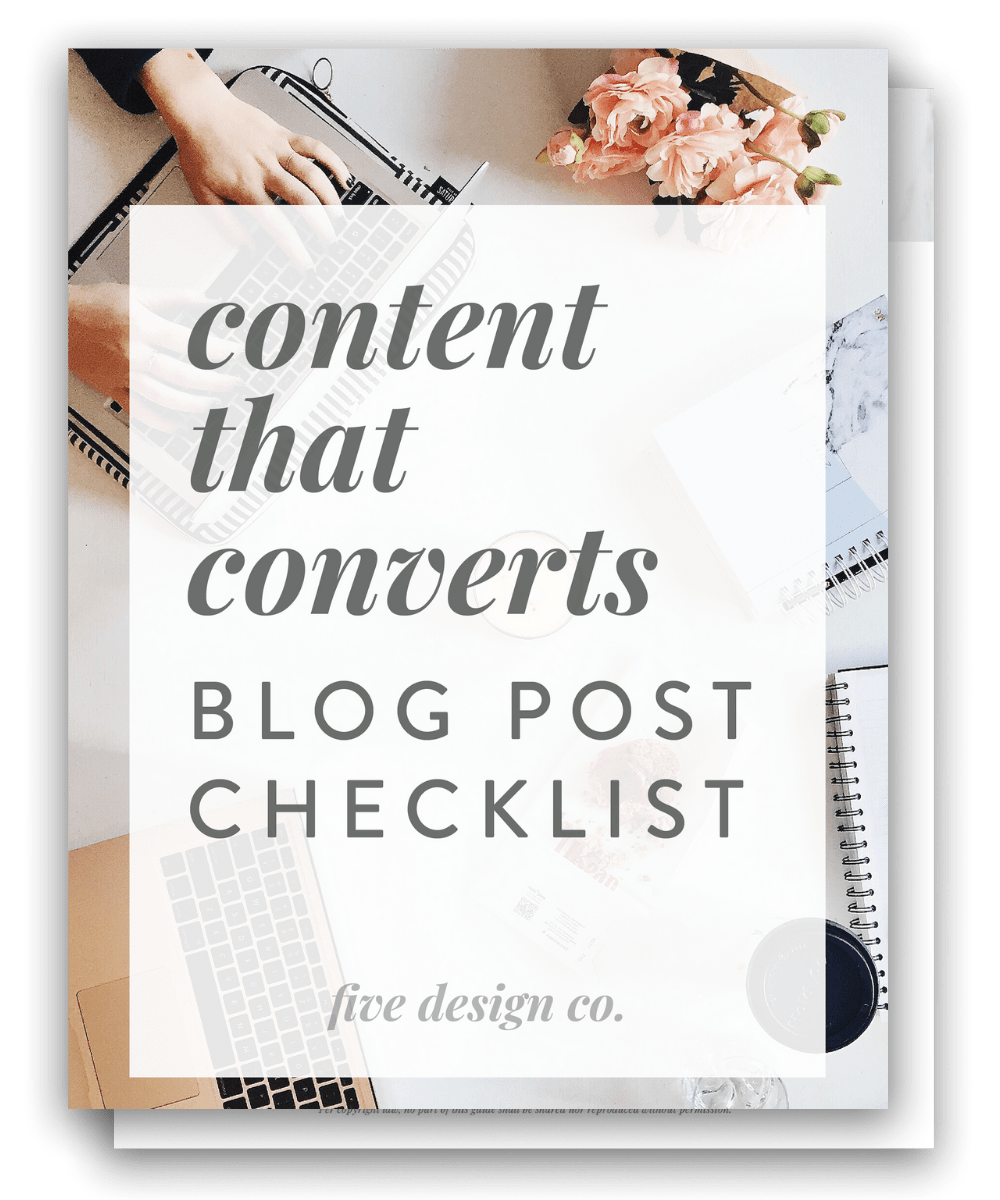How to Write a Good Blog Post
In the world of blogging, there’s a wide range of style and structure that works well for different people, brands and purposes. Some blogs thrive off lengthy personal posts, some with shorter, more direct journalistic writing and plenty of citations, and others do best with beautifully branded, image-heavy posts.
There’s really no right or wrong way to approach blogging—though, for small business owners and entrepreneurs, it typically makes sense to use your blogging platform as a means to growing your business.
With that in mind, here are my top tips for writing quality blog posts that help to grow your business and brand!
Why blogging is so beneficial for your business & brand
First, just a note on the importance of blogging for business owners: it’s so beneficial that I recommend all businesses include a blog on your website!
Here’s why:
Blogging boosts your SEO. Blogging is one of the best methods of growing your website’s SEO and traffic! That’s because (if done right 😉), blog posts are published regularly and contain lots of relevant keywords that help people find your website and, thus, your business.
Blogging builds your brand authority. Regular, helpful blog content helps to build your authority on your topic area and establish you as an expert in your field—which, of course, helps build rapport with your potential customers/clients.
Blog posts are a key ingredient in content marketing. Blog posts provide the helpful, share-able content you’ll need for content marketing—one of the most impactful strategies to grow your website traffic and audience.
So, strategic blogging is incredibly important for small businesses, especially if you’re just starting out!
What should you blog about?
There’s a wide, wide range of blog post content you can use, depending on your particular industry, business, and areas of expertise.
Squarespace blog posts can include text, images, embedded videos, file downloads and more—so the sky’s the limit in terms of the content you can include in your blog posts.
It doesn’t matter so much what you share, as long as you’re meeting your blog’s overarching purpose: The primary goal is to share valuable content that’s useful to your target audience and relevant to your business products and services.
The relevancy part is key! Your blog’s purpose is to attract the “right” type of people to your website—those who may ultimately be interested in purchasing your products or services down the road.
Some options for useful & valuable blog content:
sharing useful tips that help your readers (aka, solve a problem they’re having)
informing your readers of what you do and what you can offer them (maybe with some behind-the-scenes of your 1:1 services or product creation)
promoting a new product or service launch—what’s available, who it’s for, how it’s helpful, etc.
sharing expertise that establishes you as an industry expert
compiling other useful resources for your target audience
So, whichever type of post(s) are a good fit for your business, let’s get into how to craft a quality blog post around them!
How to write a good blog post
Here are the top tips I recommend for structuring and writing your blog posts, so they can ultimately help achieve your business goals—whether that’s making sales, landing new clients, or growing your website traffic or email list:
1. Know your audience
The very first step to good blogging, before you even begin writing, is to know who you’re writing for.
If you haven’t already, take some time to clearly define your target audience. This means thinking through (and being crystal clear on): Who exactly is your ideal customer, client or reader?
Who is the type of person you can most help with your business products or services? What are their “pain points?” What problems or questions do they have that you can help solve?
It’s important to know your business’ target audience so you can specifically write your blog posts to attract this particular reader.
2. Craft a clear & engaging title
This perhaps seems obvious, but it’s essential to have a clear, engaging, and SEO-rich title for each blog post.
What’s an SEO-rich title? It’s a title that includes specific keywords describing your blog post content—and those should be the same keywords your target audience is actually using to search for this particular content.
You can use a free tool like CoSchedule’s Headline Analyzer to test out different blog post titles and determine which is the most SEO-friendly.
In addition to including the proper keywords, your blog post title should also compel your reader to want to click through and read the blog post. This means crafting titles that clearly articulate the content inside of them, and are worded with language and terminology that makes sense and is meaningful to your ideal audience.
A quality blog post title helps your blog posts perform well, because it helps get the right people to see them—and read them.
3. Start with “what” & “why”
In your blog post intro (the first paragraph or two), explain what exactly you’re going to share in this post and why it’s important to your readers.
Your ideal reader should be able to read the first paragraph of your blog post and think to themselves: “Ooh, I like where this is going” or “Cool, I want to hear more about this.”
They need to know quite quickly that they’re in the right place to learn about the topic they came to you to learn about, or find an answer to the question they’re trying to answer (or the problem they’re trying to solve, etc.).
Unfortunately, it doesn’t matter how helpful and amazing your content is down the page if you don’t connect with and draw in your readers right away up top.
4. Use strategic, keyword-rich headings
It’s important to organize and structure your blog posts with thoughtful, hierarchical headings.
In Squarespace, you have three heading styles (well, four if you’re on Squarespace 7.1!). These styles (Heading 1, Heading 2, etc.) are accessed via your text editor, so you can easily call upon them as you’re writing your blog posts.
Besides the SEO benefits of headings (they help search engines understand and rank your blog post content!), it’s important for your readers’ experience, as it helps to break up the text and walk them through the different sections of your post—many readers, whether consciously or not, will first skim headings before choosing to delve into the full content of your blog post.
The Squarespace headings are designed to be used in hierarchical order (Heading 1 for the highest-level content, Heading 2 next, and so on).
If you’d like to style your headings differently than they came in your site template, you can do so in your Squarespace style editor (Design > Site Styles).
You’ll see there are three different heading styles in use on this post—can you spot them? 👀
5. Show your personality
One of the awesome things about blogging is that it helps to bring out your brand’s personality and thus build a deeper connection and level of trust with your audience.
Showing your personality could include things like:
sharing behind-the-scenes stories or snapshots to connect your readers to your products, services or brand
telling personal stories (origin stories—how you got here—are a good one)
using humor
running a series specific to your brand (we do some “Notes from Mel” here)
Your personal expression could also include design elements like the layout, fonts and colors of your blog, or signing off with a custom branded blog signature.
6. Give a call-to-action
To achieve business goals above and beyond just sharing your words with your audience, every blog post should include a specific call-to-action. What do you want your readers to do after reading your post?
This could be any number of things:
a button to visit something / join something / buy something
a link to another page or resource
a freebie download (yay opt-in gift!)
a written summary of the article’s takeaway and what the reader is encouraged to do
social share buttons and an invitation to share the post with someone else who would like it
Each post should have at least 1-2 (if not more!) ways for your audience to do something with the information or inspiration they’ve received from reading your post. You can give them these opportunities at the end of your article or throughout the text if that makes more sense.
💸 Use code PARTNER10 for 10% off Squarespace
This post contains affiliate links through which I may earn a commission if you choose to purchase, at no additional cost to you. As always, these are products or services I personally use & love!
7. Offer ways to contact you
If the business purpose behind your blog posts includes something that your readers might want to contact you for (like a question about your services), you’ll want to make it super-duper easy for them to reach out.
Totally your choice how you’d like to be contacted—via email, your website contact form, tagging you on social media… but whichever it is, just be sure it’s clear on each blog post how your readers are best able to reach you.
8. Promote your relevant content
I’ve shared this one lots before too (see my full archives of tips for setting up your Squarespace blog), but it’s a great idea to use your newer blog posts to link back to other existing content on your site.
You can link to other relevant pages or blog posts directly within your text (like I just did!).
And/or you can create a Related Posts reel highlighting other blog posts with similar content your readers might be interested in.
To set this up you’ll either use a Squarespace summary block and sort the displayed posts by category or tag, or install a related posts plugin that does that for you automatically (here’s more about my favorite Squarespace related posts plugin!).
Here’s an example of my own related posts reel, highlighting additional blogging resources:
9. Proofread, proofread, proofread
Not all business owners or entrepreneurs (or even professional bloggers for that matter) are natural writers or grammar experts. Totally okay. You don’t have to be the world’s most perfect wordsmith to create compelling and useful blog content. You don’t have to be a spelling champion to be seen as an authority on your topic.
But you do need to put some care and attention into your blog posts—the same as you would to any other element of your work.
While blog posts may not be as monumental as your premium products or services, they’re also not just “fluff”—they’re an extension of your business and your brand. And, very often (especially for online businesses!), they’re the first point of contact your business has with a new potential client.
If you want to make a good first impression with your prospective clients, you’ll want to be sure your blog post is well-crafted with attention to your brand and business goals.
More Squarespace blogging tips + resources:
Want to write content that grows your business & brand?
My Blog Post Checklist is designed to help your blog posts meet your business goals.













